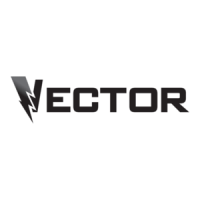
Do you have a question about the Vector CANcaseXL and is the answer not in the manual?
| Interface | USB |
|---|---|
| Channels | 2 |
| CAN Channels | 2 |
| CAN Bit Rates | 10 kbit/s to 1 Mbit/s |
| USB | USB 2.0 |
| Power Supply | Via USB |
| Operating System Compatibility | Windows |
| Operating Voltage | 5V (via USB) |
| Supported Protocols | CAN, LIN |
Explains how to use the manual, its structure, and conventions.
Details symbols, formatting, and conventions used in the manual for clarity.
States the company's ISO 9001:2000 certification.
Outlines the company's right to change documentation and software without notice.
Provides contact details for technical support via phone and email.
Lists registered trademarks and their owners, including Microsoft.
Overview of the CANcaseXL and CANcaseXL log devices and their capabilities.
Details the physical connectors like USB, Binder, and D-SUB9 for the devices.
Explains the meaning of the LEDs (Rx, Tx, Err) on the devices.
Covers operating modes, extra LEDs, piezo buzzer, memory card, and battery.
Provides instructions on how to replace plug-in transceiver boards.
Lists detailed specifications like housing, channels, microcontroller, and temperature range.
Contact information for Vector Informatik GmbH in Germany.
Contact information for Vector CANtech, Inc. in USA.
Contact information for Vector Japan Co., Ltd. in Japan.
Contact information for Vector France SAS in France.
Contact information for VecScan AB in Sweden.
Contact information for Vector Korea IT Inc. in Korea.
Contact information for Vector GB Limited in UK.
Explains how to use the manual, its structure, and conventions.
Details symbols, formatting, and conventions used in the manual for clarity.
States the company's ISO 9001:2000 certification.
Outlines the company's right to change documentation and software without notice.
Provides contact details for technical support via phone and email.
Lists registered trademarks and their owners, including Microsoft.
Lists the hardware and software prerequisites for using the devices.
Explains driver sources and versioning for device installation.
Introduces the configuration tool for managing Vector devices.
Covers measurement applications, Device Manager, and Power Manager.
Step-by-step guide for installing the device drivers on Windows 2000.
Instructions on how to update existing drivers for the device on Windows 2000.
Steps to verify if the device drivers are installed correctly on Windows 2000.
Step-by-step guide for installing the device drivers on Windows XP.
Instructions on how to update existing drivers for the device on Windows XP.
Steps to verify if the device drivers are installed correctly on Windows XP.
Step-by-step guide for installing the device drivers on Windows Vista.
Instructions on how to update existing drivers for the device on Windows Vista.
Steps to verify if the device drivers are installed correctly on Windows Vista.
Detailed steps for performing a loop test for CAN communication.
Detailed steps for performing a loop test for FlexRay communication.
Detailed steps for performing a loop test for MOST communication.
Steps to verify the correct installation of the device and its drivers.
Guide to updating or correcting driver installations if issues are found.
Contact information for Vector Informatik GmbH in Germany.
Contact information for Vector CANtech, Inc. in USA.
Contact information for Vector Japan Co., Ltd. in Japan.
Contact information for Vector France SAS in France.
Contact information for VecScan AB in Sweden.
Contact information for Vector Korea IT Inc. in Korea.
Contact information for Vector GB Limited in UK.